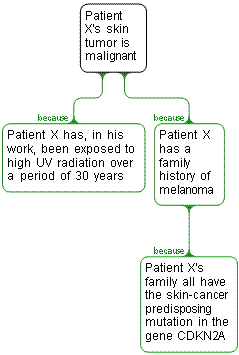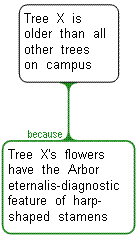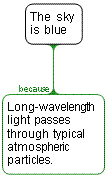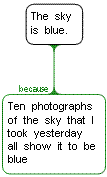The Science Of Scientific Writing Set 6 Set 6-Basis boxes • Second page • Third page • Example • Exercise 1 • Exercise 2 • Exercise 3 • Exercise 4-Quiz 1 • Fourth page • Exercise 5-Quiz 2 • Writing about Evidence • Exercise 6 • Arguments and Explanations • Final page Set 6.
OVERVIEW: The way to well-written science
PART I: Paragraphs and Sentences
SET A: Paragraphs: The Maps Behind Them
SET B: Paragraphs: Using Maps to Meet Readers' Expectations
SET C: Paragraphs with Something Extra: Points and Tails
SET D: The Generic Section: Expectations and Maps as Blueprints
SET E: Scientific Sections: The Methods and Results
SET F: Scientific Sections: The Discussion
SET G : Scientific Sections: The Introduction
SET H : Sentences
SET I : The Paper as a Whole
PART II: The Paper and its Sections
SET 1: Argument Parts
SET 2: Indicator Words
SET 4: Locating Arguments in Prose
SET 5: Rationale's Essay Planner
SET 6: Evidence in Arguments: Basis Boxes
Synthesis 1: Position-Early Paragraphs
Synthesis 2: Position-Final Paragraphs
Synthesis 3: Writing a Discussion I
Synthesis 4: Writing a Discussion II
Why it's important NOT to introduce explanatory reasons into an argument
In Set 1 we briefly considered the difference between explanatory and argumentative reasons. Now that you have feel for the importance of evidence in arguments, it is worthwhile to revisit this distinction. Keeping explanatory reasons out of a map is usually quite difficult when we first start mapping, and in considering why, we can identify some important features we should all aim for when composing maps.
Let's start with a simple question. Consider the two maps below:
 ...........
...........
From the two statements below pick the one that you think is most true, and drag it to the desktop.
A. The map on the left presents a more scientific argument in favour of the claim that the sky is blue.
B. The map on the right presents a more scientific argument in favour of the claim that the sky is blue.
We'll think about the "right" answer at the end of this page.
For scientists, it is particularly important to work hard at separating the explanations and arguments. If you are writing up some exciting new results, you may feel the heart of your paper IS some new explanation. If that is the case, then your most important task is NOT the best possible presentation of the explanation itself, but the best possible argument about why YOUR explanation is better than OTHER explanations. Any explanation presented in isolation can be made to look good - it is how it shapes up when compared to others that counts.
If you can accept that arguing about scientific explanations has parallels with a court-room style of argument, then thinking about the effectiveness of the two maps below should clarify why an explanatory emphasis is inherently weak:


I think most would agree that Kumar would feel very hard done by if he was convicted on the basis of the first "argument". The higher incidence of petty theft in lower socio-economic groups is a fact, but it does not allow us to conclude that every poor person is a born kleptomaniac.
In a court-room scenario like this one, the information in the left-hand map could be introduced argumentatively to support the idea that Kumar had a motive. If you have watched some court-room dramas on TV, you will probably be aware that, in law, the existence of motive carries far less weight than evidence that the crime was committed.
Getting a bit more "scientific", compare these two maps:
 ...........
...........
The map on the left is all very interesting in its details, and would provide a good explanation as to why Patient X's tumor had turned malignant - IF it had. But if we are interested in whether the tumor is or is not malignant (as is no doubt the question uppermost in Patient X's mind!) it is the evidence presented in the second map that is directly relevant..
The information presented in the left-hand map is of course not irrelevant - and how relevant it is hinges on the strength of the two explanations: e.g. in people with a mutation in CDKN2A, what percentage of skin tumors turn malignant? If it is 100% then it is deductively conclusive - but this type of powerful linkage, i.e. complete explanatory sufficiency, is rarely the case. More often the situation is closer to what we saw with Kumar's "motives" above, where we can intuitively understand that the higher incidence of petty theft in lower socio-economic groups does not really address the issue at hand.
Explanatory reasons are weak in an argument because they distract us from focussing on the most important reasons, those that link to evidence with DIRECT RELEVANCE to the main claim. Explanatory reasons often take us towards theory, rather than ushering us towards "hard facts" as we expect as we descend down a vertical reasoning chain. For Patient X, the metastatic features of the skin tumor are much more direct evidence of malignancy.
We can also see the distracting nature of explanatory reasons when we compare the two maps below:
 ..............
..............
A good "trick" with argument maps is to collapse each vertical chain. If we do that with the map on the left we get:

Doesn't make much
sense, does it? This may be fine if you are a lawyer mounting the infamous Chewbacca
Defence, but as scientists our aim is to make things more, not less, clear.
but as scientists our aim is to make things more, not less, clear.
Now let's apply this trick to the two maps we started with:
 .........
.........
The left-side "argument" appears rather obscure, a typical result of the introduction of an explanatory rather than an argumentative reason. The map on the right presents the more scientific argument in favour of the claim that the sky is blue, because it proceeds towards evidence that is more directly relevant to the claim being made.
An argument does not become more scientific because its reasons contain words or concepts drawn from well-known scieintific theories: it is scientific if the claim and its reasons have the same type of relationship found in ANY well-formed argument, whether that argument occurs in a court-room, a school debate or over coffee at morning tea.
Content of this page drawn in whole or part from the Austhink Rationale Exercises with permission from Austhink.